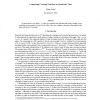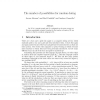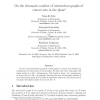4171 search results - page 16 / 835 » Choice numbers of graphs |
STOC
2001
ACM
14 years 8 months ago
2001
ACM
We show that for every fixed ? there is a quadratic time algorithm that decides whether a given graph has crossing number at most and, if this is the case, computes a drawing of t...
JCT
2008
13 years 8 months ago
2008
Let G be a regular graph and H a subgraph on the same vertex set. We give surprisingly compact formulas for the number of copies of H one expects to find in a random subgraph of G...
COMBINATORICS
2004
13 years 8 months ago
2004
Let G be the intersection graph of a finite family of convex sets obtained by translations of a fixed convex set in the plane. We show that every such graph with clique number k i...
CORR
2007
Springer
13 years 8 months ago
2007
Springer
A vertex k-labeling of graph G is distinguishing if the only automorphism that preserves the labels of G is the identity map. The distinguishing number of G, D(G), is the smallest...
CPC
2004
13 years 8 months ago
2004
The strong chromatic number, S(G), of an n-vertex graph G is the smallest number k such that after adding kn/k-n isolated vertices to G and considering any partition of the vertic...



